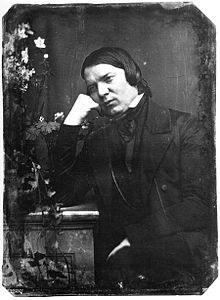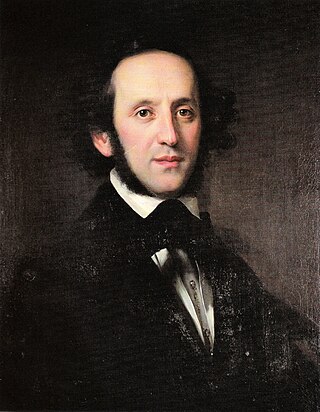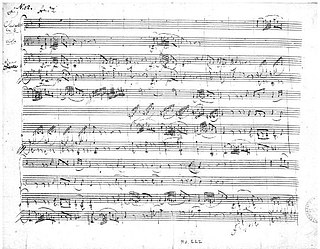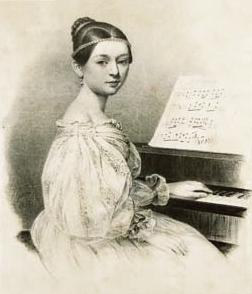
The Konzertstück for Four Horns and large orchestra in F major, Op. 86, was composed by Robert Schumann in 1849 and premiered at the Leipzig Gewandhaus in 1850.

The Konzertstück for Four Horns and large orchestra in F major, Op. 86, was composed by Robert Schumann in 1849 and premiered at the Leipzig Gewandhaus in 1850.
In 1849, Robert Schumann explored the horn as a solo instrument, dedicating to it an "Adagio and Allegro," Op. 70, before embarking on the composition of an orchestral work featuring four solo horns (having also composed the "Five Songs based on Heinrich Laube's Hunting Compendium" for men's choir and four horns, Op. 137 that same year). He worked on the sketches from February 18 to 20, and completed the orchestration from February 27 to March 11, 1849. Schumann was aware of the unusual instrumentation but also acknowledged the qualities of the new work, which he described as "something quite curious" but also as "one of my best pieces."
In a private performance with piano on October 15, 1849, at the residence of hornist Joseph Rudolf Levy, a member of the Dresden Court Orchestra, hornist Heinrich Hübler also participated. Hübler would present his own Konzertstück for the same instrumentation later.
On February 25, 1850, Julius Rietz conducted the premiere of the Konzertstück at the Leipzig Gewandhaus. The four soloists—Eduard Pohle, Joseph Jehnigen, Eduard Julius Leichsenring, and Carl Heinrich Conrad Wilcke—were members of the Gewandhaus Orchestra. Schumann noted a "friendly reception" by the audience. A reviewer for the Signale für die musikalische Welt wrote: "As strange as the idea of composing a quadruple concerto for horns may be, the composition itself is just as peculiar and valuable [...]". However, the work was deemed too lengthy.
The autograph of the Konzertstück is housed in the Berlin State Library. After Schumann had unsuccessfully offered the work to several publishers, including Simrock and Breitkopf & Härtel, Schuberth & Co. finally undertook publication of the work in 1851. [1]
In addition to the four horns used as solo instruments, the Konzertstück calls for the following orchestral instrumentation:
Piccolo, 2 flutes, 2 oboes, 2 clarinets, 2 bassoons, 2 horns ad libitum, 2 trumpets, 3 trombones, timpani, and strings.
The duration of the performance is approximately 18 to 20 minutes. The three interconnected movements of the Konzertstück bear the following tempo markings:
The combination of a solo quartet and an orchestra is uncommon for the Romantic era, reminiscent more of forms such as the Baroque concerto grosso and the classical sinfonia concertante . In Schumann's Konzertstück, there is less of a direct juxtaposition between the soloists and the orchestra; instead, both groups often interact sonically in diverse ways.
Schumann recognized the technical possibilities of the newly developed valve horn compared to the natural horn and deliberately exploited them in this work. The 1st horn, often playing in a very high range, often takes the lead, but the other three soloists are equally involved throughout the work. The difficulty, especially in the 1st part, has led to the occasional employment of two players to handle the part. [2]
The opening movement follows sonata form. After two loud orchestral chords, a motif consisting fanfare-like ascending triplets followed by a legato figure appears, which also serves as the main theme of the movement. In the development section, a lyrical secondary theme dominates.
After only a short break, the slow, Romanze middle movement in D minor ensues, in ternary form. The main theme, played by oboe, violas and cellos, is taken up by the horns and spun out canonically. The middle section of the movement is in B Major and features rich chromaticism.
A triple trumpet fanfare introduces the highly spirited third movement, whose momentum and thematic design are shared with the first movement. In the development section of the finale, which is also in sonata form, a reminiscence of the Romance theme from the middle movement resurfaces. [3]

The Piano Concerto in A minor, Op. 54, by the German Romantic composer Robert Schumann was completed in 1845 and is the composer's only piano concerto. The complete work was premiered in Dresden on 4 December 1845. It is one of the most widely performed and recorded piano concertos from the Romantic period.

The Piano Concerto No. 1 in D minor, Op. 15, is a work for piano and orchestra completed by Johannes Brahms in 1858. The composer gave the work's public debut in Hanover, the following year. It was his first-performed orchestral work, and his first orchestral work performed to audience approval.

The term romance has a centuries-long history. Applied to narrative ballads in Spain, it came to be used by the 18th century for simple lyrical pieces not only for voice, but also for instruments alone. The Oxford Dictionary of Music states that "generally it implies a specially personal or tender quality".
The Cello Concerto in A minor, Op. 129, by Robert Schumann was completed in a period of only two weeks, between 10 October and 24 October 1850, shortly after Schumann became the music director at Düsseldorf.

The Piano Concerto No. 20 in D minor, K. 466, was composed by Wolfgang Amadeus Mozart in 1785. The first performance took place at the Mehlgrube Casino in Vienna on 11 February 1785, with the composer as the soloist.

Felix Mendelssohn's Violin Concerto in E minor, Op. 64, MWV O 14, is his last concerto. Well received at its premiere, it has remained among the most prominent and highly-regarded violin concertos. It holds a central place in the violin repertoire and has developed a reputation as an essential concerto for all aspiring concert violinists to master, and usually one of the first Romantic era concertos they learn. A typical performance lasts just under half an hour.
Camille Saint-Saëns composed his Cello Concerto No. 1 in A minor, Op. 33, in 1872, when he was 37 years old. He wrote this work for the French cellist, viola da gamba player and instrument maker Auguste Tolbecque. Tolbecque was part of a distinguished family of musicians closely associated with the Société des Concerts du Conservatoire, France's leading concert society. The concerto was first performed on January 19, 1873, at the Paris Conservatoire concert with Tolbecque as soloist. This was considered a mark of Saint-Saëns' growing acceptance by the French musical establishment.

Faschingsschwank aus Wien, Op. 26, is a solo piano work by Robert Schumann. He began composition of the work in 1839 in Vienna. He wrote the first four movements in Vienna, and the last on his return to Leipzig.
The Symphony No. 4 in D minor, Op. 120, composed by Robert Schumann, was first completed in 1841. Schumann heavily revised the symphony in 1851, and it was this version that reached publication.
Carl Heinrich Hübler was the hornist in the Dresden Royal Court orchestra from 1844 until his retirement in 1891. He was appointed royal chamber musician in 1851 and 1886 was given the title chamber virtuoso, in recognition of his merits.

A clarinet–viola–piano trio, often titled "Trio for Clarinet, Viola and Piano" is a work of chamber music that is scored for clarinet, viola, and piano; or is the designation for a musical ensemble of a group of three musicians playing these instruments. This combination of instruments differs from other combinations, as the viola and the clarinet share approximately the same musical range, but not the same tone quality.
Carl Maria von Weber wrote his Clarinet Concerto No. 1 in F minor, Op. 73 for the clarinettist Heinrich Bärmann in 1811. The piece is highly regarded in the instrument's repertoire. It is written for clarinet in B♭. The work consists of three movements in the form of fast, slow, fast. It was premiered in Munich on 13 June 1811, with Maximilian I Joseph of Bavaria in attendance.
Carl Maria von Weber wrote his Clarinet Concerto No. 2 in E♭ major, Op. 74, J. 118 in 1811, and premiered on December 25, 1813. It is composed of three movements:

The Three Romances for Oboe and Piano, Op. 94 is a composition by Robert Schumann, his only composition for oboe. It was composed in December 1849. The work consists of three short pieces in A-B-A form, and it was written during what was speculated to be one of Schumann's manic episodes.
A concert piece is a musical composition, in most cases in one movement, intended for performance in a concert. Usually it is written for one or more virtuoso instrumental soloists and orchestral or piano accompaniment.
The Introduction and Allegro appassionato (Konzertstück) for piano and orchestra in G major, Op. 92, was composed by Robert Schumann in September 1849. It received its first performance in Leipzig on February 14, 1850, with Clara Schumann at the piano with Julius Rietz conducting. The work was published in 1852. The work takes around 15 minutes to perform.

The Piano Concerto in A minor, Op. 7, was composed by Clara Wieck, better known as Clara Schumann after her later marriage to Robert Schumann. She completed her only finished piano concerto in 1835, and played it first that year with the Leipzig Gewandhaus Orchestra, conducted by Felix Mendelssohn.

Robert Schumann's Five Pieces in Folk Style, Op. 102 is a set of five short pieces for cello and piano, composed in 1849 and published in 1851 with a dedication to cellist Andreas Grabau. It was Schumann's only published work designed explicitly for performance by cello and piano, though the pieces also appeared in a version prepared by Schumann for violin and piano. The first edition's title page reads "ad libitum violine".